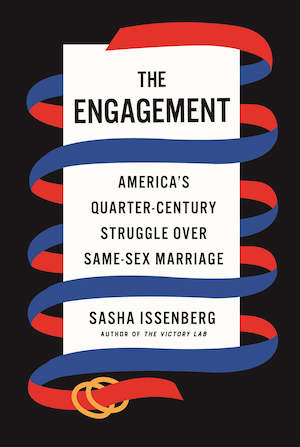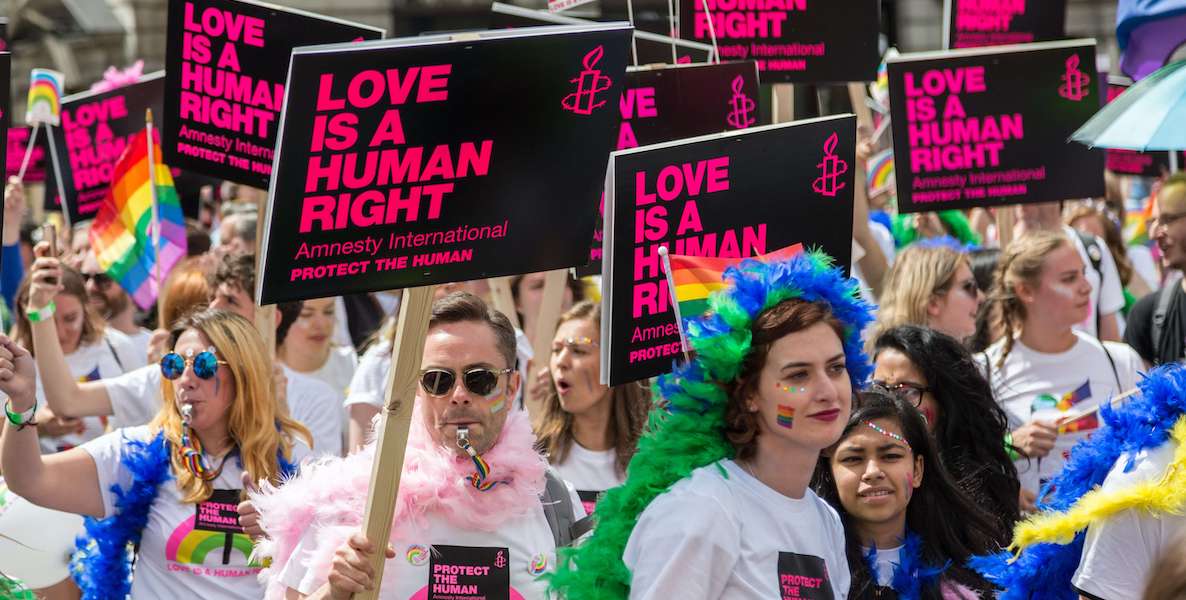[ED NOTE: We’re running this excerpt in anticipation of next week’s Citizen Speaks powered by Comcast NBCUniversal and Fitler Club event. Executive Editor Roxanne Patel Shepelavy will speak with author Sasha Issenberg about the path to success for gay marriage, what it says about our American project, and the lessons to be learned for our ongoing civil rights movements. Register for the event, happening at Fitler club on Tuesday, August 3, at 7pm, here, or via any of the registration buttons below.]
 There wasn’t anything to look at, and then there was, and then it was hard to look at anything else. Over the course of a few months in 1996, gay marriage transmogrified from a thought experiment on which few Americans had ever had reason to formulate a position into a subject that no one in political life could escape.
There wasn’t anything to look at, and then there was, and then it was hard to look at anything else. Over the course of a few months in 1996, gay marriage transmogrified from a thought experiment on which few Americans had ever had reason to formulate a position into a subject that no one in political life could escape.
As is often the case in American politics, each side imputed more strategy to the opposition than either was capable of. Those on the right assumed gay-rights advocates had intentionally conceived a multiyear lawsuit in Hawaii as a back door to the mainland, using the Constitution’s full faith-and-credit clause to compel the nation as a whole to adopt a local court’s liberal reinterpretation of marriage. The same gay-rights advocates who laughed at such a claim nonetheless believed that the Defense of Marriage Act had been concocted by Republican Party officials as, in the words of Human Rights Campaign executive director Elizabeth Birch, “a ploy by the floundering Dole for President campaign to drive a wedge between the gay community and President Clinton.”
It was not until the following decade that either side developed anything that could properly be considered a national strategy, or worthy of the specific paranoias of their opponents. Once Vermont created civil unions in 2000, bestowing upon same-sex couples every equity except the word marriage, both sides realized a battle would be inevitable and ongoing. Only at that point did the infrastructure of the perpetual campaign—single-issue groups, multiyear plans, purpose-built tactics—emerge to scaffold the intense debate.
The first efforts to professionalize the politics around gay marriage, starting in the mid-1990s, were secretly cultivated in dueling power centers of the Mountain West. Within the gay community, a galaxy of covert donors orbiting around Denver software millionaire Tim Gill remade the gay-rights movement in their own image, ideologically conservative and strategically radical. Five hundred miles away, in Salt Lake City, they found their match in a yet-more-clandestine cadre of officials at the Church of Latterday Saints, whose well-funded political operations were—at least in the context of its own traditionalist movement—strategically conservative and ideologically radical.
In a quarter century, gay marriage went from being a test of the moral and political imagination to settled policy in fifty states and a simple, even banal, fact of everyday life. Many younger Americans today have difficulty understanding what the conflict was all about.
Before 1996, gay marriage’s rise to prominence was driven by smaller-scale factors: principle, hubris, rivalry, opportunism, individual initiative, and institutional incentive. It was not only the major historical shifts of the 1990s that created opportunity for outsider movements and lone political entrepreneurs, but minor serendipities, many of them recognizable only in retrospect. In fact, without a series of coincident actuarial quirks one-fifth of the way around the globe from Washington—including an unexpected death and the arrival of a seventieth birthday—no president might have had to contend with the thorny question of same-sex marriage for decades more.
The notion of an issue thrust on the power centers of American government from its periphery via shortsighted machinations and fortuitous timing was so foreign to the political class that its members lacked a language to describe it. Clinton’s first public statement—“This has always been my position on gay marriage,” he would eventually say at a May press conference two weeks after the bill was unveiled—gave a misleading impression that it had been a perennial concern throughout his career. Bill Clinton hadn’t always had a position on gay marriage any more than he had always had positions on bailing out the Mexican peso or going to war in Bosnia.
The Engagement is the story of the birth and life of an issue. It is the tale of those on both sides who conspired to invent, elevate, and war over a change in policy, and the country transformed along with that debate. In a quarter century, gay marriage went from being a test of the moral and political imagination to settled policy in fifty states and a simple, even banal, fact of everyday life. Many younger Americans today have difficulty understanding what the conflict was all about.
Pollsters regularly observe that they have never seen public opinion on a single issue move as dramatically and swiftly as it has on same-sex marriage. At the time Bill Clinton pondered the politics of the Defense of Marriage Act, barely one-quarter of Americans said they supported the rights of gays and lesbians to marry. Over the next fifteen years the number of those who embraced what the gay-rights movement has successfully branded “marriage equality” would nearly double—an unimaginable shift in attitudes thought to be set deeply in the everlasting values of religion, family, and tradition.
The speed with which Americans became invested in the issue is a prime example of what the political scientist E. E. Schattschneider called “the tremendous contagiousness of conflict.” What had begun as a jostle for primacy among Honolulu activists for control of a single event-planning committee expanded—through both strategy and happenstance—to ensnare interest groups, state governments, religious denominations, national political parties, and even the presidency. “So great is the change in the nature of any conflict likely to be as a consequence of the widening involvement of people in it that the original participants are apt to lose control of the conflict altogether,” Schattschneider observed in his 1960 work The Semisovereign People. “A host of new considerations and complications are introduced, and a multitude of new resources for a resolution of conflict becomes available; solutions inconceivable at a lower level may be worked out at a higher level.”
Barack Obama’s announcement in the spring of 2012 that he was among those who had undergone an “evolution” ensured that his would be the third consecutive White House to have its bid for a second term molded by its handling of gay marriage. In 1996, Bill Clinton had the Defense of Marriage Act shoved at him and embraced it apologetically, aware there was only one place where a mainstream politician could afford to land on the issue. Midway through the presidency of his successor, George W. Bush, Massachusetts became the first state to authorize same-sex marriages. Bush found political advantage by recasting the matter as a three-sided issue, championing a Federal Marriage Amendment to the constitution, which he knew his Democratic opponent couldn’t possibly support. (The amendment would have precluded states from recognizing a right under their own constitutions for gay couples to marry.)
Eight years later, Obama swung fully in the opposite direction, first by ordering his Justice Department to treat the Defense of Marriage Act as unconstitutional and cease defending the law in court. Then he went further, saying that he believed states should be free to marry gay couples, a position no serious candidate for president had ever before been willing to espouse. (As a senator seeking the presidency, Obama backed civil unions for gay couples but not marriage.) By then, the physics of the issue had been so upended that critics accused him of having adopted the stance to win votes.
Like his two predecessors, Obama’s machinations were shaped by both personal principle and political expediency. The explanation for his shift acknowledged how otherwise nimble politicians struggled to catch up with a country that had changed around them in ways they couldn’t fully understand or explain. “What you’re seeing is, I think, states working through this issue—in fits and starts, all across the country. Different communities are arriving at different conclusions, at different times,” Obama explained in May 2012. “And I continue to believe that this is an issue that is gonna be worked out at the local level, because historically, this has not been a federal issue, what’s recognized as a marriage.”
The American debate over marriage will appear infinitesimally short, a meteor that gathered the stray matter and floating detritus of a country’s messy politics and grew so fiery that it singed bodies in its path before abruptly burning out for good. But in its day it seemed capable of illuminating the entire moral universe.
Stunningly, it would be only another three years until Obama put the weight of the United States government behind the proposition that the rights of gays to marry should be a state issue no longer. In the four cases bundled together as Obergefell v. Hodges, the Supreme Court accepted the solicitor general’s argument that the country could not sustain a range of conflicting opinions reflected in local law.
That decision arrived just ten days after Donald Trump announced his candidacy for president in 2015. Yet over a seventeen-month campaign—a revanchist enterprise that preyed on nearly every identity-based grievance except those involving sexual orientation—Trump barely acknowledged the momentous ruling and, after the election, declared the same-sex mar- riage debate moot. “It’s irrelevant because it was already settled. It’s law. It was settled in the Supreme Court. I mean it’s done,” Trump told Lesley Stahl of CBS’s 60 Minutes in his first interview as president-elect. “And I’m fine with that.” One of the most formidable challengers to emerge against Trump’s reelection in 2020 was an upstart politician whose marriage to another man was almost entirely incidental to his political identity.
The timeline to that tidy resolution was beyond the wildest hopes of gay-rights activists just years before. When, in 2005, a group of political operatives and litigators convened at the urging of Tim Gill’s donor circle to draft an aspirational long-range strategy—a confidential document that would guide much of their activity—they outlined a path toward a Supreme Court affirming what they called the “freedom to marry.” They set a goal of 2025.
Once this end was in sight, participants in and observers of the battles to defend, define, and expand marriage in America worked to shoehorn the narrative into familiar paradigms, in which civil-rights movements slowly build an intellectual and political critical mass to power the legal tactics and political reforms necessary for change. Activists stuck in such deliberate, plodding work often find solace in Martin Luther King Jr.’s observation that “the arc of the moral universe is long, but it bends toward justice.”
Against that backdrop, the American debate over marriage will appear infinitesimally short, a meteor that gathered the stray matter and floating detritus of a country’s messy politics and grew so fiery that it singed bodies in its path before abruptly burning out for good. But in its day it seemed capable of illuminating the entire moral universe.
From The Engagement: America’s Quarter-Century Struggle Over Same-Sex Marriage by Sasha Issenberg. Reprinted by permission of Pantheon Books, an imprint of the Knopf Doubleday Publishing Group, a division of Penguin Random House. Copyright © 2021 by Sasha Issenberg. Get your copy at Philly AIDS Thrift @ Giovanni’s Room here.
Photo by Ian Taylor / Unsplash




